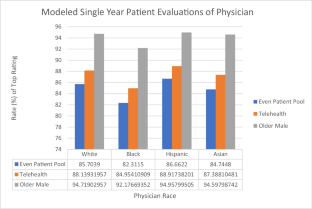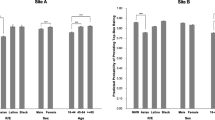Abstract
Background
Patient and provider race and gender concordance (patient and physician identify as the same race/ethnicity or gender) may impact patient experience and satisfaction.
Objective
We sought to examine how patient and physician racial and gender concordance effect patient satisfaction with outpatient clinical encounters. Furthermore, we examined factors that changed satisfaction among concordant and discordant dyads.
Design
Consumer Assessment of Healthcare Provider and Systems (CAHPS) Patient Satisfaction Survey Scores were collected from outpatient clinical encounters between January 2017 and January 2019 at the University of California, San Francisco.
Participants
Patients who were seen in the eligible time period, who voluntarily provided physician satisfaction scores. Providers with fewer than 30 reviews and encounters with missing data were excluded.
Main Measures
Primary outcome was rate of top satisfaction score. The provider score (1–10 scale) was dichotomized as “top score (9-10)” and “low scores (<9).”
Key Results
A total of 77,543 evaluations met inclusion criteria. Most patients identified as White (73.5%) and female (55.4%) with a median age of 60 (IQR 45, 70). Compared to White patients, Asian patients were less likely to give a top score even when controlling for racial concordance (OR: 0.67; CI 0.63–0.714). Telehealth was associated with increased odds of a top score relative to in-person visits (OR 1.25; CI 1.07–1.48). The odds of a top score decreased by 11% in racially discordant dyads.
Conclusions
Racial concordance, particularly among older, White, male patients, is a nonmodifiable predictor of patient satisfaction. Physicians of color are at a disadvantage, as they receive lower patient satisfaction scores, even in race concordant pairs, with Asian physicians seeing Asian patients receiving the lowest scores. Patient satisfaction data is likely an inappropriate means of determining physician incentives as such may perpetuate racial and gender disadvantages.


Similar content being viewed by others
Data Availability
Data will not be made available.
Code Availability
Code can be made available without associated data.
References
Olaisen RH, Schluchter MD, Flocke SA, Smyth KA, Koroukian SM, Stange KC. Assessing the longitudinal impact of physician-patient relationship on functional health. Ann Fam Med. 2020;18(5):422–9. https://doi.org/10.1370/AFM.2554.
Martinez KA, Keenan K, Rastogi R, et al. The association between physician race/ethnicity and patient satisfaction: an exploration in direct to consumer telemedicine. J Gen Intern Med. 2020;35(9):2600–6. https://doi.org/10.1007/S11606-020-06005-8.
Takeshita J, Wang S, Loren AW, et al. Association of racial/ethnic and gender concordance between patients and physicians with patient experience ratings. JAMA Netw Open. 2020;3(11):e2024583. https://doi.org/10.1001/jamanetworkopen.2020.24583.
Jackson JL, Chamberlin J, Kroenke K. Predictors of patient satisfaction. Soc Sci Med. 2001;52(4):609–20. https://doi.org/10.1016/S0277-9536(00)00164-7.
Cooper-Patrick L, Gallo JJ, Gonzales JJ, et al. Race, gender, and partnership in the patient-physician relationship. JAMA. 1999;282(6):583–9. https://doi.org/10.1001/JAMA.282.6.583.
Murphy GP, Awad MA, Tresh A, et al. Association of patient volume with online ratings of California urologists. JAMA Surg. 2018;153(7):685–6. https://doi.org/10.1001/JAMASURG.2018.0149.
Murphy GP, Radadia KD, Breyer BN. Online physician reviews: is there a place for them? Risk Manag Healthc Policy. 2019;12:85–9. https://doi.org/10.2147/RMHP.S170381.
Murphy GP, Awad MA, Osterberg EC, et al. Web-based physician ratings for California physicians on probation. J Med Internet Res. 2017;19(8). https://doi.org/10.2196/JMIR.7488.
Petrullo KA, Lamar S, Nwankwo-Otti O, Alexander-Mills K, Viola D. The patient satisfaction survey: what does it mean to your bottom line? J Hosp Adm. 2013;2(2). https://doi.org/10.5430/jha.v2n2p1.
Siegrist RB. Patient satisfaction: history, myths, and misperceptions. Virtual Mentor. 2013;15(11):982–7. https://doi.org/10.1001/VIRTUALMENTOR.2013.15.11.MHST1-1311.
Saha S, Komaromy M, Koepsell TD, Bindman AB. Patient-physician racial concordance and the perceived quality and use of health care. Arch Intern Med. 1999;159(9):997–1004. https://doi.org/10.1001/ARCHINTE.159.9.997.
Haviland MG, Morales LS, Reise SP, Hays RD. Do health care ratings differ by race or ethnicity? Jt Comm J Qual Saf. 2003;29(3):134–45. https://doi.org/10.1016/s1549-3741(03)29016-x.
Murray-García JL, Selby JV, Schmittdiel J, Grumbach K, Quesenberry CPJ. Racial and ethnic differences in a patient survey: patients’ values, ratings, and reports regarding physician primary care performance in a large health maintenance organization. Med Care. 2000;38(3):300–10. https://doi.org/10.1097/00005650-200003000-00007.
Kumar D, Schlundt DG, Wallston KA. Patient-physician race concordance and its relationship to perceived health outcomes. Ethn Dis. 2009;19(3):345–51.
LaVeist TA, Nuru-Jeter A, Jones KE. The association of doctor-patient race concordance with health services utilization. J Public Health Policy. 2003;24(3-4):312–23. https://doi.org/10.2307/3343378.
Laveist TA, Nuru-Jeter A. Is doctor-patient race concordance associated with greater satisfaction with care? J Health Soc Behav. 2002;43(3):296–306.
Taira DA, Safran DG, Seto TB, et al. Do patient assessments of primary care differ by patient ethnicity? Health Serv Res. 2001;36(6 Pt 1):1059–71.
Wallis CJD, Jerath A, Coburn N, et al. Association of surgeon-patient sex concordance with postoperative outcomes. JAMA Surg. 2021. https://doi.org/10.1001/JAMASURG.2021.6339.
Meghani SH, Brooks JM, Gipson-Jones T, Waite R, Whitfield-Harris L, Deatrick JA. Patient-provider race-concordance: does it matter in improving minority patients’ health outcomes? Ethn Health. 2009;14(1):107–30. https://doi.org/10.1080/13557850802227031.
Rogo-Gupta LJ, Haunschild C, Altamirano J, Maldonado YA, Fassiotto M. Physician gender is associated with Press Ganey patient satisfaction scores in outpatient gynecology. Women’s Heal issues Off Publ Jacobs Inst Women’s Heal. 2018;28(3):281–5. https://doi.org/10.1016/j.whi.2018.01.001.
Woods SE, Heidari Z. The influence of gender on patient satisfaction. J gender-specific Med JGSM Off J Partnersh Women’s Heal Columbia. 2003;6(4):30–5.
Okunrintemi V, Valero-Elizondo J, Patrick B, et al. Gender differences in patient-reported outcomes among adults with atherosclerotic cardiovascular disease. J Am Heart Assoc. 2018;7(24):e010498. https://doi.org/10.1161/JAHA.118.010498.
Alsaif A, Alqahtani S, Alanazi F, Alrashed F, Almutairi A. Patient satisfaction and experience with anesthesia: a multicenter survey in Saudi population. Saudi J Anaesth. 2018;12(2):304–10. https://doi.org/10.4103/sja.SJA_656_17.
U.S. Census Bureau QuickFacts: San Francisco County, California. https://www.census.gov/quickfacts/fact/table/sanfranciscocountycalifornia/POP010220. Accessed November 14, 2022.
Patel I, Chang J, Srivastava J, Feldman S, Levender M, Balkrishnan R. Patient satisfaction with obstetricians and gynecologists compared with other specialties: analysis of US self-reported survey data. Patient Relat Outcome Meas. 2011;2:21–6. https://doi.org/10.2147/PROM.S15747.
Kruse CS, Krowski N, Rodriguez B, Tran L, Vela J, Brooks M. Telehealth and patient satisfaction: a systematic review and narrative analysis. BMJ Open. 2017;7(8):e016242. https://doi.org/10.1136/BMJOPEN-2017-016242.
Ramaswamy A, Yu M, Drangsholt S, et al. Patient satisfaction with telemedicine during the COVID-19 pandemic: retrospective cohort study. J Med Internet Res. 2020;22(9):e20786. https://doi.org/10.2196/20786.
Mueller BR, Lawrence S, Benn E, et al. Disparities in telehealth utilization in patients with pain during COVID-19. Pain Reports. 2022;7(3):E1001. https://doi.org/10.1097/PR9.0000000000001001.
Campos-Castillo C, Anthony D. Racial and ethnic differences in self-reported telehealth use during the COVID-19 pandemic: a secondary analysis of a US survey of internet users from late March. J Am Med Inform Assoc. 2021;28(1):119. https://doi.org/10.1093/JAMIA/OCAA221.
Brown SH, Griffith ML, Kripalani S, Horst SN. Association of health literacy and area deprivation with initiation and completion of telehealth visits in adult medicine clinics across a large health care system. JAMA Netw Open. 2022;5(7):e2223571–1. https://doi.org/10.1001/JAMANETWORKOPEN.2022.23571.
Chang ES, Simon M, Dong XQ. Integrating cultural humility into health care professional education and training. Adv Health Sci Educ Theory Pract. 2012;17(2):269–78. https://doi.org/10.1007/S10459-010-9264-1.
Tang C, Tian B, Zhang X, et al. The influence of cultural competence of nurses on patient satisfaction and the mediating effect of patient trust. J Adv Nurs. 2019;75(4):749–59. https://doi.org/10.1111/JAN.13854.
Davidson KW, Shaffer J, Ye S, et al. Interventions to improve hospital patient satisfaction with healthcare providers and systems: A systematic review. BMJ Qual Saf. 2017;26(7):596. https://doi.org/10.1136/BMJQS-2015-004758.
Argueza BR, Saenz SR, McBride D. From diversity and inclusion to antiracism in medical training institutions. Acad Med. 2021;96(6):798–801. https://doi.org/10.1097/ACM.0000000000004017.
Liao L, Chung S, Altamirano J, et al. The association between Asian patient race/ethnicity and lower satisfaction scores. BMC Health Serv Res. 2020;20(1):678. https://doi.org/10.1186/s12913-020-05534-6.
Butler C, Baskin AS, Mmonu NA, et al. Patient satisfaction in a safety net urology clinic. Urol Pract. 2021;8(2):168–75. https://doi.org/10.1097/UPJ.0000000000000177.
Saha S, Hickam DH. Explaining low ratings of patient satisfaction among Asian-Americans. Am J Med Qual Off J Am Coll Med Qual. 2003;18(6):256–64. https://doi.org/10.1177/106286060301800606.
Alfred M, Ubogaya K, Chen X, Wint D, Worral PS. Effectiveness of culturally focused interventions in increasing the satisfaction of hospitalized Asian patients: a systematic review. JBI Database Syst Rev Implement Reports. 2016;14(8):219–56. https://doi.org/10.11124/JBISRIR-2016-003048.
Truong M, Paradies Y, Priest N. Interventions to improve cultural competency in healthcare: a systematic review of reviews. BMC Health Serv Res. 2014;14(1):1–17. https://doi.org/10.1186/1472-6963-14-99/TABLES/1.
Dunsch F, Evans DK, Macis M, Wang Q. Bias in patient satisfaction surveys: a threat to measuring healthcare quality. BMJ Glob Heal. 2018;3(2):694. https://doi.org/10.1136/BMJGH-2017-000694.
Acknowledgements
We gratefully acknowledge the assistance of Nizar Hakam, Behnam Nabavizadeh, Natalie Rios, and Michael Sadighian particularly for their roles in reviewing provider profiles. All represent the UCSF Department of Urology and were otherwise uncompensated for their work.
Author information
Authors and Affiliations
Contributions
NS: data analysis/interpretation and manuscript drafting and editing. NH: data analysis/interpretation and manuscript editing. JH: project design and data collection and analysis. AF: project design, data analysis, and manuscript editing. DD: project design and manuscript editing. NP: project design and manuscript editing. DS: project design, data analysis, manuscript editing, and supervision. BB: project design, data analysis, manuscript editing, and supervision.
Corresponding author
Ethics declarations
Ethics Approval
Institutional Review Board (IRB) exemption was granted for this project. Data was primarily de-identified and/or otherwise publicly available.
Consent to Participate
Not applicable.
Consent for Publication
Not applicable.
Conflict of Interest
The authors declare no competing interests.
Additional information
Publisher’s Note
Springer Nature remains neutral with regard to jurisdictional claims in published maps and institutional affiliations.
Rights and permissions
Springer Nature or its licensor (e.g. a society or other partner) holds exclusive rights to this article under a publishing agreement with the author(s) or other rightsholder(s); author self-archiving of the accepted manuscript version of this article is solely governed by the terms of such publishing agreement and applicable law.
About this article
Cite this article
Shaw, N.M., Hills, N., Holler, J. et al. The Impact of Patient–Physician Racial and Gender Concordance on Patient Satisfaction with Outpatient Clinic Visits. J. Racial and Ethnic Health Disparities (2023). https://doi.org/10.1007/s40615-023-01676-5
Received:
Revised:
Accepted:
Published:
DOI: https://doi.org/10.1007/s40615-023-01676-5





